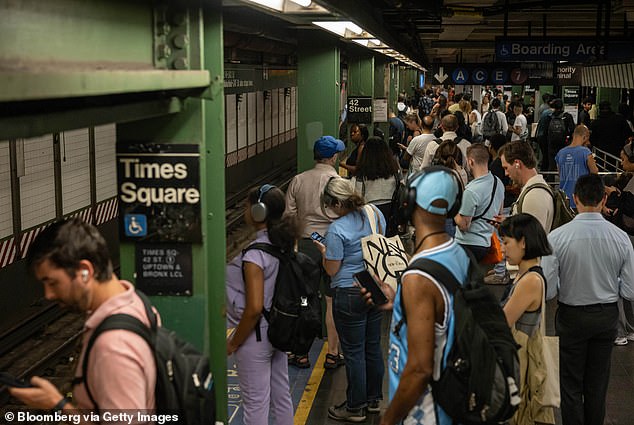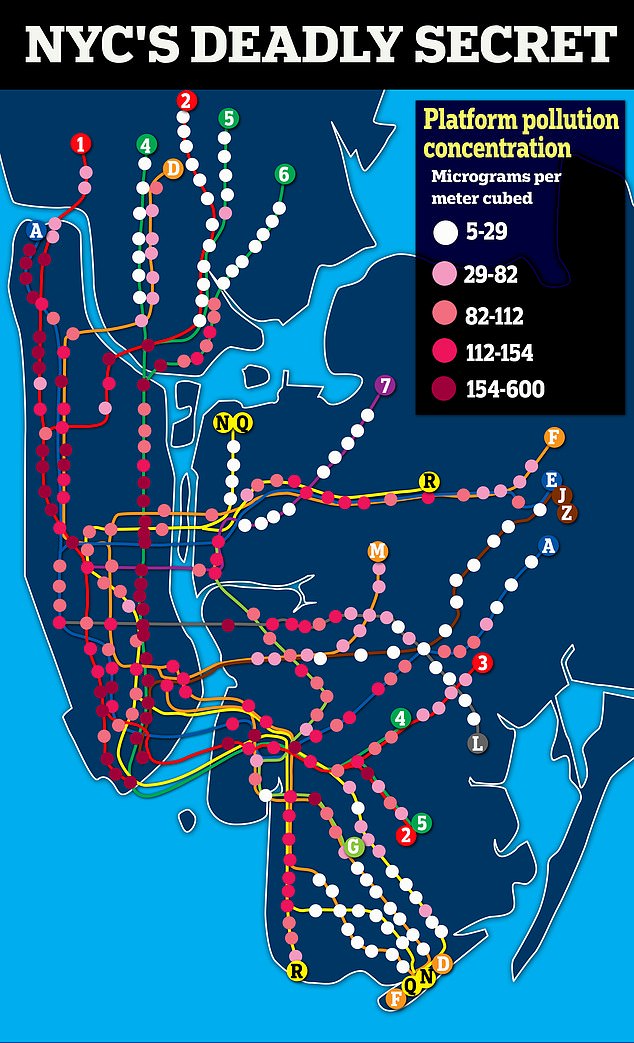New York City’s subways have a reputation for being dangerous, but a new study shows the air is deadly, too.
A new study finds that subway commuters are exposed to deadly pollution levels up to 10 times higher than the safe limit.
Researchers examined the amount of fine particulate matter (PM2.5) – tiny particles released during combustion – that can penetrate deep into the lungs and bloodstream, where they can cause damage linked to cancer, cardiovascular disease and premature death.
The team found that the average concentration of pollution on platforms was 139 micrograms per cubic metre and 99 micrograms per cubic metre on trains, compared to the World Health Organization’s limit of 15 micrograms.
Researchers have examined particulate matter (PM2.5) on platforms and train carriages and found that commuters are exposed to excessive amounts of iron from the trains
However, the World Health Organization’s limits are based on 24 hours of exposure. Many commuters breathe in the amount while commuting for 30 minutes or standing on the platform for 10 to 20 minutes waiting for a train.
Research has shown that even inhaling PM2.5 for a few hours can cause breathing problems, especially in people with asthma and other respiratory problems.
Researchers at New York University (NYU) examined return journeys from start to finish across 19 metro lines and 368 stations, using data from 3.1 million residents.
Measurements were taken in each metro car and at each stop, while the cars were on the platform.
The levels peaked as the train pulled into the station, and they found that the abrupt stop would stir up existing pollutants that had built up in the tunnel over the years.
The rubbing of metal wheels and brakes released metal particles which made up a large part of the particle concentration.
Masoud Ghandehari, a professor at NYU and lead author, said Bloomberg: ‘We noticed that when a train arrives at the station, the concentration in the air increases enormously. About 15 to 20 seconds after the train has left, the concentration slowly decreases.
‘That means it’s the debris at the bottom of the tunnel that is stirred up and the air quality is deteriorating.’
PM2.5 comes from cars, coal-fired power plants, trains and waste incineration, all of which are activities that occur all over the world, no matter where you live.
The pollution does not directly kill people, but it does affect their general health and makes them vulnerable to all kinds of ailments, such as lung, brain and heart problems, which can ultimately lead to death.
The researchers also found that the combination of pollution and poor ventilation at some stations, particularly in lower-income areas such as the Bronx, led to higher concentrations of particulate matter.

The team found that the average concentration of pollution on platforms was 139 micrograms per cubic metre and 99 micrograms per cubic metre on trains, compared to the World Health Organization’s limit of 15 micrograms.
According to the study, published in PLOS One, exposure levels among black and Hispanic workers were 23 percent higher than those of white commuters, due to longer commutes and varying pollution levels along train lines.
“Most of the jobs are in New York City’s financial districts, like Midtown and Downtown Manhattan,” Ghandehari said The guard.
“People with lower incomes often live further away from these job centers. So their travel time is longer, which means their exposure is going to be greater.”
The study found that residents of Upper Manhattan neighborhoods, including Washington Heights and Inwood, are most exposed to subway pollutants because of the distance they travel to work.
This was compared to people living in Midtown Manhattan, where people may live closer to their workplace.



